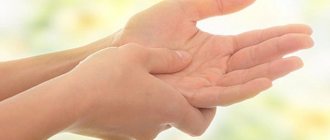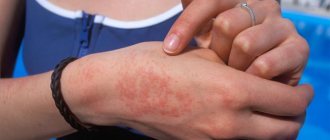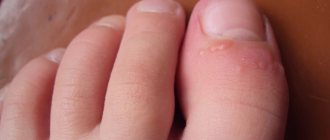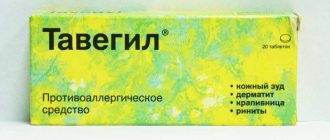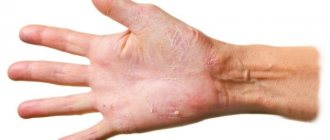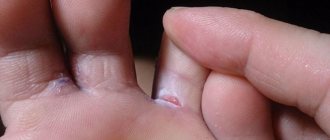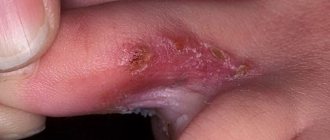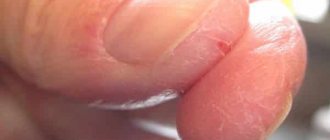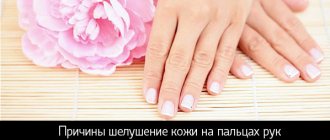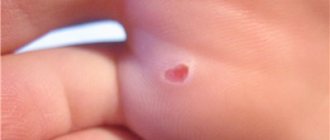Causes
Itching between the fingers occurs for many reasons. The main ones:
- bacterial or fungal infection;
- dermatitis, eczema, psoriasis;
- allergic reaction;
- the presence of parasites in the body;
- avitaminosis;
- kidney pathologies cause intoxication, resulting in skin problems;
- hormonal disorders;
- scarlet fever (in a child).
In addition, gallbladder diseases can provoke the problem. Because of them, bile enters the human blood, which is reflected on the skin in the form of itching, redness, swelling, peeling, and rash.
Externally similar symptoms can be caused by a large number of different diseases, which complicates the diagnosis.
Fungus
Mycosis, more often than other dermatological diseases, causes the appearance of redness between the fingers. Fungi affect the skin under favorable conditions: weakened immunity, previous infections, taking certain medications, bad habits. The disease is transmitted through contact with the carrier or his personal belongings. Signs of fungal infection can be seen in the photo below.
In addition to redness, the following symptoms indicate the presence of mycosis:
- the appearance of blistering rashes that bleed when damaged;
- inflammation, swelling of the epidermis;
- itching, burning, peeling, formation of a scaly layer.
Allergic dermatitis
The skin can become inflamed due to a protective reaction upon contact with an irritant (medicines, household chemicals, cosmetics, food).
Among the provoking factors that cause allergies are:
- irregular, poor nutrition, consumption of junk food or allergenic foods;
- hereditary predisposition;
- endocrinological or immune diseases;
- overwork, nervous tension, lack of sleep.
In case of allergies, the epidermis becomes irritated, turns red, swells and burns, and rashes form. In advanced cases, the skin peels off and itches, and general health worsens.
Eczema
A dermatological disease manifested by the following symptoms:
- thickening and peeling of the affected area;
- formation of blistering rashes;
- the appearance of itching;
- change in skin color.
The disease can be triggered by both pathologies of internal organs and systems, and a reaction to irritating substances (household chemicals, personal hygiene products) . People working in the following areas are at risk:
- production and processing of chemicals;
- construction (contact with harmful materials - paint, building mixtures);
- cleaning;
- cosmetology;
- Agriculture;
- food industry.
Factors influencing the appearance of eczema:
- exposure to household chemicals and hygiene products;
- gastrointestinal diseases;
- skin irritation afterwards;
- hereditary factor;
- placing hands in an environment with high humidity;
- hormonal problems;
- parasites.
Scabies
Scabies is a dermatological disease caused by the scabies mite. The symptoms are still the same: redness of the skin and severe itching. The rash caused by scabies can be “caught” in everyday life: by touching an infected person or his personal belongings. Scabies mites live in bedding and upholstered furniture.
Lichen
Some types of lichen can be infected from domestic and street animals . The disease rapidly spreads throughout the body, the skin begins to itch, inflammation occurs, spots and rashes appear, redness and peeling of the epidermis.
The disease must be treated with drug therapy prescribed by a dermatologist. Self-medication and traditional medicine should not be practiced. If the infection occurred from a pet, then the pet must also be examined and treated.
Psoriasis
The affected areas of the epidermis become red, swell, then become covered with a scaly layer and become wet. Psoriasis, as a rule, cannot be cured completely; the disease takes a chronic form. However, it can be muffled, providing the patient with long-term remission.
Other reasons
- Avitaminosis. Due to a lack of vitamins, a person’s performance decreases, the condition of his skin worsens, it can turn red and crack.
- Household chemicals. If hands come into direct contact with chemicals when cleaning or washing, a person risks developing dermatological diseases such as eczema and dermatitis.
- Inflammation and redness in the finger area often occurs in people with dry skin. The problem may arise due to a hereditary predisposition or frequent use of hygiene products.
- Insect bites can cause irritation between the fingers. During a bite, a small amount of poison gets under the skin, causing irritation or allergies.
Homemade hand masks
The importance of hand masks cannot be overstated. They help the skin protect itself from external factors, household chemicals and, of course, cosmetics, and restore its structure.
Dry hands become soft and smooth if you apply an oatmeal mask for 10-15 minutes and then rinse it off with warm water and apply moisturizer.
Preparing the mask itself will not take much time. To do this, pour a small amount of warm water over the oatmeal. Let it sit for 10 minutes and then apply it to your hands. Instead of water, you can use hot milk with the addition of homemade cream and cottage cheese. A possible mask option includes honey, butter and fatty cottage cheese. All this is diluted to the desired consistency with warm milk.
A mask made from mashed potatoes and milk is effective for dry skin.
Therapy
Treatment is prescribed by a dermatologist. If the cause is diseases of the internal organs, then consultation with a specialist in the relevant field is recommended .
Medicines
To reduce itching and remove inflammation, the doctor prescribes antihistamines (Claritin, Suprastin, Fenistil, Cetrin).
To suppress bacteria, antibiotics are needed, prescribed by a doctor individually in accordance with the diagnosis and characteristics of the body. Erythromycin ointment is suitable for external treatment.
In the presence of fungal infections, hormonal ointments and creams are used, such as Clotrimazole, Ketonazole and Miconazole. Resorcinol, Rivanol, boric acid may be prescribed. Such therapy is carried out only after testing and confirmation of the presence of mycosis. Patients are not recommended to contact other people so as not to infect them.
If a scabies mite has been detected, external preparations with a disinfecting and anti-inflammatory effect (for example, Wilkinson's ointment) are prescribed.
To relieve the symptoms of dermatitis, use hormonal ointments (Advantan, Lokoid, Fucicort). They are also used in the treatment of psoriasis. In addition, this disease is treated with Tar and Zinc ointments, as well as solid oil-based products (Solipsor, Kartalin, Magnipsor).
Traditional methods
After consulting with your doctor, you can use traditional methods of treatment to relieve symptoms . The following remedies work well at home:
- Blueberry compress. Pour 100 grams of blueberries with water and boil for five minutes, cool. Mash the boiled berries with a wooden spoon, place on gauze and apply to the affected skin for several hours.
- You can relieve symptoms by soaking your hands in a warm solution of baking soda for a couple of minutes (you need 1 tablespoon of soda for 1 liter of water). Another option is to soak cotton pads in this solution and wipe the affected area.
- The affected area is lubricated with warm vegetable oil (for example, olive). This helps the skin heal.
- Carrot compress. You need to grate one carrot, place it on gauze and apply it to the reddened area.
- A tablespoon of coltsfoot is ground using a meat grinder, then poured with milk (about half a glass is needed). Apply the resulting paste to the affected skin overnight, putting a plastic bag or glove on your hand.
- Fish oil, which has medicinal qualities, helps with rashes, cracks and peeling. In cosmetology, the product is often used for skin care. The fat is applied for half an hour and then washed off.
- For allergic skin diseases, remedies using duckweed help. You need to take 1 teaspoon of the dried plant and 50 ml of medical alcohol, then let it brew for a week, strain and squeeze. The tincture is taken three times a day, adding 20 drops of tincture to a quarter glass of water.
- The duckweed is finely ground and mixed with honey (1:5). You need to form small tablets from the mixture. Take one or two of these tablets three times a day.
- Infusion of celery root. For two tablespoons of the plant you need to take 250 ml of water. Leave for 3 hours. Take a third of a glass three times a day. This remedy helps well with allergic dermatitis.
- If infected with a fungus, the skin can be wiped with tangerine juice.
- Pour water over 2-3 birch branches (along with leaves), heat to a boil. The broth is cooled and filtered. You need to hold your hands in the healing liquid.
Exolocin for nail fungus: what buyers say (scam or truth)
Fungal nail diseases are widespread among the population. According to statistics, onychomycosis affects every fifth inhabitant of the Earth. Infection occurs on the beach, in the gym, or in a beauty salon. Also, fungus can develop after a finger injury, due to weak immunity and excessive sweating, poor hand and foot hygiene, and wearing tight, poor-quality shoes.
It is impossible not to treat mycosis, because under the influence of microorganisms allergic reactions appear, chronic pathologies worsen and large surfaces of the body are affected. Penetration of the fungus into internal organs is dangerous due to generalized damage to the entire body.
Exolocin, a remedy made according to the recipe of Siberian shamans, will help prevent dangerous consequences.
Exolocin: composition and pharmacological properties
Since the drug does not contain a fatty base, Exolocin is a transparent gel. It is quickly absorbed by the affected tissues, leaving no traces or staining the skin. The active substances penetrate deep into the epidermis and nail plates and destroy the mycelium. As a result of treatment, the skin becomes soft, scales and bad odor disappear. Patients notice the first effect of using Exolocin a few days after the start of therapy.
The composition of the fungicidal agent Exolocin is based on components of natural origin. Each of them has an antimycotic and restorative effect. A full course of treatment stops the process of mycelium reproduction and prevents re-infection.
What is included in the product:
- Essential oils of tea tree and hemp seed strengthen nails, protect surrounding tissues, and inhibit the activity of fungal flora.
- Chaga and lapacho extracts remove unpleasant odors, regulate sweating, and inhibit the proliferation of microbes.
- Maclura juice and kukui oil - fight pathogenic agents, restore damaged tissue, eliminate itching and other symptoms of mycosis.
- Betulin and cordyceps - improve the appearance of the skin and improve the functioning of the immune system.
Exolocin gel treats mycosis of any type. Its components affect the immune system and encourage it to produce antibodies to the fungus. After treatment, nails grow back healthy, smooth, dense and with an even surface.
Main pharmacological properties of Exzolocin:
- Normalizes the water balance of the feet.
- Soothes sensitive dermis, eliminating flaking and dryness.
- Quickly relieves the characteristic symptoms of fungus - itching between the fingers, inflammation, pain.
- Destroys infection, heals wounds and microcracks, removes corns.
- Destroys all pathogenic flora that lives on the skin of the feet.
The active components of Exolocin gel have a comprehensive effect on nails affected by fungus - fungicidal, antibacterial, anti-inflammatory and regenerating.
Exolocin for fungus: method of application
By strictly following the instructions for using Exolocin, and without missing a single procedure throughout the course, a person can quickly cure nail fungus and achieve a lasting result.
Use the gel according to the following scheme:
- The limbs are washed with warm water and laundry soap and dried with a disposable napkin.
- Apply a thin layer of the product to the damaged surface, carefully working through itchy and flaky areas. Additionally, the interdigital spaces are lubricated, since here the concentration of microorganisms is as high as possible.
- Gently massage the entire foot until the gel is completely absorbed.
- If possible, put finger guards on your fingers - the “greenhouse effect” will enhance the effect of the active substances.
For medicinal purposes, it is recommended to perform the procedure 2 times a day, for example, in the morning and in the evening. Course duration is 2, 3 or 4 weeks. The period depends on the degree of damage to the nail by fungus.
To prevent foot fungus infection, all family members should use Exolocin. Close contact with someone who is sick increases the risk of infection at home.
Expected effect of using Exolocin:
- On the first day, redness, itching, odor, sweating, and peeling go away.
- By day 8, the mycelium dies completely.
- After 30 days, the body forms long-term immunity to fungal diseases of the skin and nails.
Side effects and contraindications
Judging by what experts write in reviews about Exolocin for nail fungus, the drug is absolutely safe in terms of allergic reactions and other side effects. It destroys fungus and maintains the beauty of nails and skin.
The antimycotic does not cause addiction. The manufacturer has not established any contraindications for the use of Exzolocin. Pregnant and lactating women can use the drug against fungus without fear of the effect on the child. Children can be treated for fungus with Exolocin gel from the age of 6.
A simple test will help you verify that the gel is hypoallergenic. The user should squeeze out a small amount of the medicine and spread it on the foot. If no discomfort or rash occurs within 1 to 2 hours, Exolocin can be used as directed.
People who have tried various antifungal remedies on themselves say that Exolocin gel is better than its analogues. When nails become shapeless and crumbling, itching, flaking and weeping wounds bother them, a person begins to panic and looks for effective medications for himself. Made from natural extracts and extracts, the product powerfully works against pathogenic flora and saturates the skin and nails with beneficial vitamins, amino acids and other substances.
So what is Exolocin - a scam or does it really help against fungus, as the manufacturer claims? If you do not pay attention to isolated negative reviews on the Internet and carefully study the composition and pharmacological properties, it is not difficult to understand that the gel can cope with mycosis with proper and regular use. The manufacturer cannot guarantee a 100% cure, because it is unknown with what responsibility a particular consumer will approach treatment.
Antifungal agent Exolocin - where to buy, how much it costs
If you try to find out what the price for Exolocin for fungus is at a pharmacy, the pharmacist will not be able to answer this question, since the drug is sold only on the Internet on the manufacturer’s official website and on distributors’ resources.
You can look for a useful product in large pharmacy chains that import various new products. But the price will be much higher than what is found on the Internet.
Having found out how much Exolocin costs in a pharmacy in a big city, anyone will want to save money and go looking for medicine on websites.
Residents of Russia can order it for 990 rubles; in Ukraine, the drug is sold for 408 hryvnia. On the territory of Belarus - 35 rubles in local currency, in Kazakhstan - 4959 tenge. For large purchases, the manager offers a discount.
Customer Reviews
Testing of Exolocin showed that 95% of patients resolved the problem of nail fungus within 2 weeks of therapy. The product did not cause any side effects. Only slight redness of the tissue appeared, which disappeared on its own in a short time.
Also, customer reviews confirm that Exolocin gel has a pleasant texture and smell and is quickly absorbed by the skin. The deodorizing effect is manifested by a slight cooling sensation. There are no hormonal components.
What consumers say about Exolocin:
What are the dangers of lack of treatment?
The danger of skin diseases is often underestimated, perceiving dermatological pathologies solely as a cosmetic problem that poses a threat only to appearance. Often, such careless attitude towards skin health can lead to serious consequences. Fungal diseases are especially dangerous, poisoning the body and harming other organs.
Cracked skin becomes an entry point for infections that affect the entire body. Skin diseases can initiate oncogenic processes.
Timely treatment is the way to avoid serious consequences and complications. An advanced disease is a threat both to your wallet (the more advanced the disease, the more difficult, and therefore more expensive, treatment) and to your health.
Treatment method
If there is redness between the fingers and itching, treatment will take place after a detailed diagnosis. Having determined the cause of the disease, the doctor will develop complex therapy and select individual medications.
Allergies between the fingers are eliminated by taking antihistamines such as Tavegil, Suprastin, Diazolin. They allow you to relieve swelling, redness and eliminate itching if your baby’s fingers itch. If hand fungus is diagnosed, treatment will consist of applying antifungal agents such as:
These medicinal substances have a fungicidal effect, they eliminate the pathogen and relieve unpleasant symptoms. The flaky ball of skin disappears, and in its place a new healthy layer of skin forms if the child undergoes vitamin therapy. Vitamins A and E accelerate the process of cell regeneration in the epidermis, improve its elasticity - it stops cracking and turning red. Your doctor may prescribe medications for topical use, such as:
- Desitin;
- Drapolene;
- Bepanten;
- D-panthenol;
- Sudocrem.
If symptoms indicate a bacterial infection, antibiotic ointments are used. Tetracycline ointment is prescribed more often than others, as it does not cause a burning sensation in children's skin and has an anti-inflammatory effect, eliminating reddened areas.
For the treatment of rubella, measles and chickenpox, the treatment regimen and drugs are selected depending on the age and nature of the disease. It is very important to treat the interdigital spaces with antiseptic agents. Chlorhexine has proven itself better than others.
No matter how hard you try to protect your child from infectious diseases, you are unlikely to succeed. The good news is that today you should start getting vaccinated against measles, rubella and other infectious diseases. If you get vaccinated, you can reduce the likelihood of developing diseases, even if your baby comes into contact with carriers.
Additional recommendations
If you do not want to expose your child to synthetic drugs or they are contraindicated for him for some reason, you can treat an allergic reaction or a fungal infection that causes redness between the fingers at home using folk recipes.
A simple and painless way to relieve swelling and redness between the fingers is to use potato pulp. Potatoes are crushed and applied to the redness. If a fungus occurs, it goes away due to the fact that the starch contained in potatoes dries out the skin and creates conditions unfavorable for the proliferation of fungal cells. If you have allergies, the gentle action of the juice soothes irritation and relieves inflammation.
Honey mixed with Kalanchoe has a good effect on the skin. The ointment is applied to the inflamed skin for 20 minutes, 2 times a day and washed with cold water. This tandem of natural ingredients increases blood flow in the affected area, relieves swelling, and improves local skin immunity.
Baths of medicinal herbs such as chamomile, calendula, St. John's wort and string will help soothe irritation. They have an excellent antiseptic effect and antibacterial properties, so they will not only help reduce the inflammatory process, but also eliminate pathogenic flora that may multiply on the skin.
Causes of redness on the hands between the fingers
There are many different conditions that cause redness and itching between the fingers. The causes of such discomfort are usually:
- individual intolerance to one or more components of household chemicals and cosmetics, which additionally cause peeling of the skin;
- allergies to certain types of food or medications; allergens can directly affect the epidermis or enter the body through inhalation;
- the presence of certain infections spread by specific bacteria or fungi;
- too careful hygiene, which dries out the skin;
- mechanical skin irritation;
- dry skin due to low air humidity or uncomfortable temperature;
- scabies mite, which, biting through thin areas of skin, gets inside and lays eggs there;
- autoimmune disorders, in which the fight between immune blood cells and body cells begins, resulting in itching, roughening, redness, and peeling of the skin;
- genetic factors, when the metabolism that provides physiological hydration of the skin fails, drying and peeling of the skin occurs, accompanied by itching.
It is important to know! Itchy fingers have many causes. To avoid chronic diseases, immediate consultation with a qualified dermatologist is mandatory!
Eczema
The term “eczema” refers to inflammation of the skin, which is also called “lichen lichen.” The disease is accompanied by dry and flaky skin, red spots, and itching. The causes of eczema are as follows:
- exposure to chemicals contained in dyes, flavors, etc.;
- genetic predisposition;
- wearing too tight jewelry - bracelets, watches;
- disorders in the endocrine system;
- worms, pyogenic bacteria;
- diseases of the gastrointestinal tract.
If appropriate measures are not taken in time, the disease will become chronic.
What diseases are characterized by similar symptoms?
The appearance of redness and unpleasant itching on the hands, between the fingers, may be a symptom of the following skin diseases:
- Contact dermatitis. It usually occurs after direct exposure to some irritant. In special cases it is characterized by blisters.
- Eczema is a disease with redness and peeling of the skin. Often these symptoms are accompanied by swelling and cracks.
- Urticaria . Caused by some allergen that causes a rash.
- Psoriasis . Scaly, red rashes complement the main symptoms.
- Miliaria is the appearance of small nodules on the skin due to prolonged exposure to sweat.
- Scabies. Causes discomfort associated with painful itching and moist redness, in addition, it is a contagious disease.
- Ringworm , usually transmitted from domestic animals. A fungal disease characterized by itching in the folds between the fingers.
Infectious diseases
Pimples on the hands can be a symptom of the onset of an infectious disease, such as chickenpox or measles. However, in this case, it’s not exactly pimples that appear on the hands - the rashes are more likely to look like blisters or small blisters. It is easy to identify an infectious disease - it is accompanied by high fever, general malaise, rashes soon appear not only on the hands, but throughout the body. In this case, you need to call a doctor at home.
Traditional methods
Traditional methods of treatment allow you to get rid of the disease in a gentle and safe way, unlike chemical exposure. In addition, they are much cheaper than pharmaceutical medications.
When treating itching and redness between the fingers on the hands, it should be remembered that traditional methods and methods can only defeat superficial, non-serious causes, and more complex diseases must be treated with medications or in a complex manner .
The following remedies are considered the most popular and effective:
- Herbal baths made from decoctions of chamomile, string, and oak bark are used as anti-inflammatory, soothing and disinfecting agents.
- Homemade ointments soften the skin and relieve irritation. An ointment based on sunflower oil (1 tbsp), beeswax (50 g) and aloe juice (50 ml) effectively relieves itching and redness between the fingers. All components are heated with 50 grams of laundry soap (crushed) until completely dissolved. Apply twice a day on affected areas.
- Tincture of motherwort or valerian gives an antihistamine effect.
Where do they come from?
Pimples on the fingers can appear at the most unexpected time in women of any age, and no one is immune from this. It is important to find out the reason why they began to form. There are many such reasons, let's look at the main ones:
- The first thing you should pay attention to is the body’s allergic reactions, because they are very different for each person. Any substance can cause an allergic rash: from food products and household chemicals, to fabrics from which clothes or bedding are made. It is often impossible to find out on your own what exactly the body reacts to. But modern methods of conducting special analyzes can accurately detect the true “culprit.”
- If watery pimples suddenly begin to appear on your fingers, and your body temperature rises significantly, these are most likely symptoms of an infectious disease: chickenpox, rubella or measles.
- With fungal diseases, infection usually occurs in places where the skin is damaged or there are invisible cracks.
- Often, pimples formed between the fingers indicate a metabolic disorder. This problem causes diseases of various organs of the gastrointestinal tract.
- Heredity also plays an important role: in such cases, subcutaneous acne takes a long time and is difficult to treat. Such inflammations tend to spread throughout the skin.
- Very often, pimples that appear on the palms, back of the hands, or between the fingers are the result of active hormonal changes, which is typical for teenagers and pregnant women.
- The appearance of acne during severe nervous shock is also quite understandable. Stressful situations and “shaken” nerves disrupt the functioning of some internal organs, which, in turn, causes a rash to appear on the hands.
- And, finally, violation of basic rules of personal hygiene. Bacteria multiplying at an incredible rate can become another cause of acne on the skin. So wash your hands often!
Medications (ointments, creams)
To treat skin inflammation, prescriptions from a dermatologist are necessary. In particular, antihistamines are used to relieve symptoms and eradicate the lesion.
They are used as local preparations in the form of ointments and creams, and for oral administration in the form of tablets or drops.
Hormonal and non-hormonal ointments, depending on the cause of the disease, antifungal agents, and antiviral drugs are widely used.
Currently, Nezulin cream-gel , known for its effective effect on the affected area, has proven itself well. Reliably relieves inflammation, significantly reduces itching and irritation, and improves skin immunity.
Among ointments, Winkilson's ointment and Sulfur ointment are successfully used. The antihistamine Cetrin will help eliminate allergies and their symptoms, relieving irritation and itching. Does not have sedative properties.
What will help relieve redness?
For every woman, redness on the hands is a rather unpleasant drawback. But you shouldn’t be upset, as there are many ways to eliminate unwanted redness between your fingers. And in order for this to lead to the desired result, it is necessary to use all kinds of treatments.
Medicinal ointments
Vitaminized medicinal ointments, creams, and gels containing extracts from medicinal herbs are especially useful for normalizing the color of the skin of the hands. By increasing local immunity when applied, they help the skin become more resistant to harmful influences.
The use of cosmetic creams with herbal ingredients is allowed. The option of using medicinal ointments, which contain antiseptics and antibiotics, cannot be ruled out. Of course, only a doctor can recommend both the latest ointments and hormonal ones.
Creams for flaky skin
Flaky hand skin causes many problems for women. After all, hands are always visible, and they reflect the state of the entire body and even determine the degree to which a woman cares not only about her appearance, but also about her health. Cosmetics with a high content of fatty components can easily help cope with this problem.
The fact is that
flaky skin needs hydration .
And oil-based creams will help compensate for this deficiency. Examples of these include creams that contain grape seed oil, almond oil, and shea butter. Cream emulsion from La-Cri is also widely used. Important to remember! If you cannot cope with this disease on your own, it is better to seek advice from experienced cosmetologists or dermatologists in time.
Hand baths
It is impossible to overestimate the benefits for the skin of the hands from baths of medicinal herbs, which can reduce itching and relieve redness. The range of herbs recommended for this procedure is quite large. You can use burdock root, nettle leaves, wild strawberry, chamomile flower, string grass, yarrow, St. John's wort, celandine and sage.
To do this, first of all, you need to prepare a decoction from a mixture of plants or one of them. Dip pre-washed hands into the resulting solution and hold in it for 10–15 minutes. After the bath, be sure to dry your hands with a soft towel and apply a rich moisturizer.
Oil wraps
Oil wraps are recognized as the most fashionable and have already become widely known. Such a mysterious name does not imply an equally difficult process to perform. Any woman can perform the wrap herself.
Here's what you need to do to do this:
- Wash your hands with warm water.
- Soak a napkin with warm vegetable oil.
- Wrap your hands in an oiled napkin and finally put on the mittens. (They can be either cotton or wool, but not synthetics).
- After 1.5 - 2 hours, the wrapper is removed. The remaining oil is carefully rubbed into the skin.
- You should not wash your hands with water; you can wipe them with a flannel napkin.
It is better, of course, to do this before bed. But the choice of oil is individual: almond, avocado, jojoba, olive, etc.
Vitamin complexes
It should be remembered that when choosing vitamin complexes for skin diseases of the hands, they must include the following elements:
- vit A, E, C, increasing the body's resistance to infections;
- vit B, regulating hematopoiesis;
- vit F, which provides immunity to the skin.
Currently, the vitamin complex “Vitrum Beauty” has gained wide popularity , which, in addition to the above components, contains the necessary microelements in the form of magnesium, zinc, selenium, iodine. This drug is intended for young girls.
For older women, vitamin complexes such as “Vitrum Beauty Elite” or “Vitrum Antioxidant” are provided.
“Alphabet Cosmetic”, containing youth coenzyme Q10, as well as vitamins E, A and C essential for health, is very practical to use. For complete absorption of substances, it is recommended to take 3 tablets of different compositions.
Important to remember! Vitamin complexes must be used in courses. This is especially true in the fall or spring with an acute deficiency of nutrients.
First aid
If redness and blisters between your fingers itch, it means you need to take action urgently. Be sure to see a doctor right away to avoid making your problem worse and harming others.
It is best to stay at home during treatment. To prevent itching between your fingers from being so annoying, take note of a few tips:
- If the spot between your fingers itches, you can reduce the sensitivity with ice. Wrap it in cloth and apply it to the area that is bothering you.
- Take three hundred grams of oatmeal and fill it with two liters of hot water. Let the prepared mixture cool, and then immerse your hands in it and hold for about half an hour.
- Try to limit the use of chemicals (especially detergents and powders). Wash your hands in warm water. It is better to forget about cold and hot during treatment.
Cosmetology products
Redness and itching between the fingers occurs as a result of dry skin. When skin changes appear, it is recommended to begin treatment and constantly monitor the condition of the skin.
A variety of creams with nourishing and moisturizing effects are perfect for achieving this goal. A product consisting of several creams has a particularly beneficial effect on the skin. It is best to apply it to the skin before going to bed at night. You can wear fabric gloves. During the night, the skin will rest and in the morning it will look healthier.
Hand wraps using oils are also useful to relieve inflammation and treat skin.
Dermatological diseases
Often the cause of rashes is a dermatological disease. The most common non-contagious diseases that cause rash and itching include:
- Neurodermatitis. The skin becomes covered with small pink papules that are very itchy. Most often, this pathological condition develops against the background of allergic reactions, gastrointestinal problems, frequent stress and depression. The rash mainly affects the interdigital space and the elbow crease. This disease is chronic and requires constant prevention and treatment, this is the only way to avoid relapses.
- Darier's disease. This pathology belongs to hereditary forms and is caused by the body’s inability to absorb vitamins of group A. Initially, small pimples form on the skin, which rapidly develop, turning into overgrown plaques. Moreover, these papules are localized not only on the hands, but also on other parts of the body. Treatment requires a specific approach, so you need to seek help from a specialist.
- Miliaria is a childhood disease, although in rare cases it can occur in adults. Most often it occurs in places of high humidity, these can be the armpits, elbow bends, the space between the fingers, and the groin area. The prickly heat rash causes severe discomfort in the form of itching. You should not scratch pimples, as there is a risk of infection, and this will aggravate the situation and complicate treatment.
- Follicular keratosis. The rash resembles small bumps, similar to goose bumps. They can be localized singly or in large groups. Often, lesions appear on the area of skin between the hand and elbow, as well as in the shoulder area. This disease can manifest itself due to hormonal imbalance, metabolic problems, vitamin deficiency, and also due to the presence of toxins in the body. The cause of the appearance may also be a genetic factor.
- Psoriasis. This disease can develop due to nervousness or due to a weakened immune system. At the initial stage, small pimples appear on the skin. And after a short period of time they transform into papules and grow greatly.
- Dyshidrosis. The main symptom of this condition is vesicles - small water pimples. Most often, this rash is found on the palms, fingers, and a little less often in the wrist area. The rash causes severe itching, which often causes infection in the bursting papules. If you ignore the disease and do not treat it in a timely manner, there is a risk that the pathology will develop into weeping eczema.
As you can see, almost the same rash can appear for different reasons. This is due to the fact that the skin acts as an indicator that indicates the presence of some changes in the body.
We suggest you look at the rash on the tummy of a newborn - tell me! — kathyyy
Hand wraps and baths
Hand wrap is a very effective procedure that is performed in the evening. The use of olive oil provides a guaranteed effect regarding skin moisture and nutrition.
Note! The necessary beneficial substances have the most productive effect on the skin at night.
To carry out an oil wrap, you need to prepare honey with olive oil. Heat them to 45 C. Apply the resulting composition to the brushes, wrap with plastic wrap, and insulate well with woolen cloth.
To treat redness between the fingers and itching on the hands, you can use an oil wrap in the following composition:
- raw chicken egg yolk;
- lemon juice;
- honey;
- linseed oil.
Mix all the ingredients and carry out the wrap according to the above scheme.
Types of rash
The hands most often suffer from rashes. This is due to the fact that it is this part of the body that comes into most contact with irritants that provoke the appearance of a rash. Small pimples on the hands can be of several types:
- watery - small pimples filled with liquid;
- dry - dense and empty pimples;
- purulent - inflamed pustules, inside of which pus accumulates;
- red - resembles an insect bite in appearance, usually accompanied by severe itching;
- subcutaneous - medium-sized tubercles that have not changed their natural color.
Each individual type of rash occurs due to some problem in the body. Before starting therapy, it is worth finding out the reason why white pimples appeared on your hands. A doctor can quickly diagnose the disease and prescribe the correct treatment.
Revitalizing baths
Regenerating hand baths can also help in the fight against illness. They are usually based on infusions of medicinal herbs (chamomile, mint, sage, dill). Adding oil is also possible.
A decoction of chamomile moisturizes the skin well
To prepare such a bath, you need to brew 1 tbsp in 1 liter of boiling water. l. daisies. You need to take a bath for 20 minutes, then treat the skin with a rich cream.
In addition to herbs, heated whey can be used for a similar procedure . After such a bath, the skin will become soft, get rid of redness, peeling and cracks.
A bath using olive oil has a beneficial effect; it is recommended to do it twice a week.
First aid
If watery blisters appear on the fingers and they are very itchy, the patient should be given first aid before visiting a doctor.
You can achieve a good effect using the following simple methods:
- Lubricate your hands with the juice of a fresh cabbage leaf.
- Keep the brushes in a bath with chamomile infusion or decoction.
- Make lotions from oatmeal crushed in a blender.
- Lubricate the itchy areas with aloe juice, which should be diluted half with water.
The danger of itching is that during scratching, the infection, if present, spreads to healthy areas of the epidermis, and the itching itself becomes simply unbearable. In addition, an open wound on the skin is always a reason for the addition of another infection, which can significantly complicate the course of the initial disease.
Therefore, if small watery blisters appear on the fingers, you must try to get rid of the itching using all available methods.
How to care for the skin between your toes
There are some mandatory rules to protect the epidermis from external influences:
- Too hot water dries out the skin. Cold water causes peeling. Therefore, when washing it is necessary to correctly select the required temperature.
- When going outside in cold weather, you need to wear gloves.
- In sunny weather, to avoid drying out the skin, use a protective cream.
- Use mild soap. The best option in this case is “Children’s”.
- Peel at least 2 times a week to remove dead cells and allow the cream to penetrate deeper into the epidermis.
- Use baths, massage, necessary nourishing masks.
- Use daily creams that nourish and moisturize the skin.
Prevention
Measures to prevent hand skin problems include:
- Healthy eating (eating less sweets, confectionery, salty or spicy foods) and giving up bad habits.
- Find out which foods, materials or plants cause an allergic reaction and reduce contact with them to a minimum.
- If the skin between the fingers suffers due to scabies, cleaning of the bed linen, upholstered furniture and clothes of the patient is required.
- Careful hygiene of the entire body and hands in particular. However, you should not wash your hands too often, as this dries and destroys the protective layer.
- Do not stay in the sun for a long time (a large dose of ultraviolet radiation is harmful to the skin).
- Undergo preventive medical examinations.
- Regularly care for your skin, moisturize and nourish it.
- Use of protective latex gloves when washing and washing with household chemicals.
- Choose hypoallergenic washing powders and detergents.
Hands are more susceptible to negative factors than other parts of the body, and therefore require special protection and care.
Proper nutrition for healthy skin
If your skin is prone to inflammation or susceptibility to infectious diseases, you should pay attention to proper nutrition. The food you eat has a direct impact on the condition of your skin.
The importance of a healthy diet cannot be underestimated
Below is a list of the most harmful foods that should be avoided during skin treatment:
- Sugar . Destroys collagen, provokes inflammation.
- Refined grain . It also increases sugar levels. It is necessary to eat whole grain bread or vegetables with a high starch content (pumpkin).
- Processed food (canned vegetables). Rich in salt, which dehydrates cells, leading to rashes.
- Milk . Provokes inflammation and acne.
- Processed fats (sauce, mayonnaise, ketchup, waffles, chips). Increase cholesterol and reduce skin immunity. It is better to eat cold-pressed oils.
- Alcohol . Significantly dehydrates the epidermis.
- Fast food products . The presence of stabilizers, dyes, trans fats and other harmful substances negatively affects the condition of the skin.
- Seafood . An excess of iodine has a negative effect on the body.
- Fried food. The presence of harmful carcinogens destroys cells.
- Artificial sweeteners Harmful due to the presence of chemicals.
- Low-quality dietary supplements , vitamins. To use them, there must be the very fact of the need for use, as well as confidence in their compatibility with the body.
- Red meat . It is better to remove it from the diet, giving preference to low-fat types.
- Milk chocolate . Devoid of any benefit. It is better to use dark chocolate for food.
Women's hands need special attention and care. To maintain their attractiveness and beauty, you should provide them with proper care. If redness and itching appear between your fingers, you need to act immediately.
We should not forget that correct treatment depends on the correct diagnosis, which only a doctor can make.
This video shows a test for those with itchy hands. Find out more:
Some useful information about hand skin allergies:
Useful information from a doctor about dermatitis on the hands:
Prevention
Below is a list of tips to avoid the above problems:
- Proper diet: minimize the consumption of sweets, fatty, salty foods. Eliminate bad habits.
- Analyze your body’s reaction to allergic pathogens and avoid contact with them.
- Consistent change of bed linen.
- Compliance with personal hygiene rules.
- Avoid prolonged contact with direct sunlight.
- Do not avoid periodic preventive examinations.
- Continuous skin care for the entire body.
It is the hands that are most susceptible to fungal infections, so special attention should be paid to taking care of them. Of course, the fact that you follow all the above tips does not provide a 100% guarantee that this problem will not affect you. However, they will help avoid many unpleasant problems.
Obsessive itching is a very common symptom that can be localized in different parts of the body. Let's try to figure out what itching, as well as redness and peeling between the fingers, may indicate.
Video - Finger allergies
There are several reasons that can cause dermatitis.
- Wrong diet.
- Genetic predisposition to the disease.
- A person suffers from vitamin deficiency.
- The body's hormonal levels are disrupted.
- Various types of immune disorders are observed.
- Stress, nervousness.
Note! Sometimes the cause of skin redness can be cathedral dermatitis.
